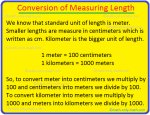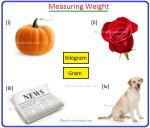Proportion Problems
We will learn how
to solve proportion problems. We know, the first term (1st) and the fourth term (4th) of a proportion are called extreme terms or extremes, and the second term (2nd) and the third term (3rd) are called middle terms or means.
Therefore, in a proportion, product of extremes = product of middle terms.
Solved examples:
1. Check whether the two ratios form a proportion or not:
(i) 6 : 8 and 12 : 16; (ii) 24 : 28 and 36 : 48
Solution:
(i) 6 : 8 and 12 : 16
6 : 8 = 6/8 = 3/4
12 : 16 = 12/16 = 3/4
Thus, the ratios 6 : 8 and 12 : 16 are equal.
Therefore, they form a proportion.
(ii) 24 : 28 and 36 : 48
24 : 28 = 24/28 = 6/7
36 : 48 = 36/48 = 3/4
Thus, the ratios 24 : 28 and 36 : 48 are unequal.
Therefore, they do not form a proportion.
2. Fill in the box in the following so that the four numbers are in proportion.
5, 6, 20, ____
Solution:
5 : 6 = 5/6
20 : ____ = 20/____
Since the ratios form a proportion.
Therefore, 5/6 = 20/____
To get 20 in the numerator, we have to multiply 5 by 4. So, we also multiply the denominator of 5/6, i.e. 6 by 4
Thus, 5/6 = 20/6 × 4 = 20/24
Hence, the required numbers is 24
3. The first, third and fourth terms of a proportion are 12, 8 and 14 respectively. Find the second term.
Solution:
Let the second term be x.
Therefore, 12, x, 8 and 14 are in proportion i.e., 12 : x = 8 : 14
⇒ x × 8 = 12 × 14, [Since, the product of the means = the product of the extremes]
⇒ x = (12 × 14)/8
⇒ x = 21
Therefore, the second term to the proportion is 21.
More worked-out proportion problems:
4. In a sports meet, groups of boys and girls are to be formed. Each group consists of 4 boys and 6 girls. How many boys are required, if 102 girls are available for such groupings?
Solution:
Ratio between boys and girls in a group = 4 : 6 = 4/6 = 2/3 = 2 : 3
Let the number of boys required = x
Ratio between boys and girls = x : 102
So, we have, 2 : 3 = x : 102
Now, product of extremes = 2 × 102 = 204
Product of means = 3 × x
We know that in a proportion product of extremes = product of means
i.e., 204 = 3 × x
If we multiply 3 by 68, we get 204 i.e., 3 × 68 = 204
Thus, x = 68
Hence, 68 boys are required.
5. If a : b = 4 : 5 and b : c = 6 : 7; find a : c.
Solution:
a : b = 4 : 5
⇒ a/b = 4/5
b : c = 6 : 7
⇒ b/c = 6/7
Therefore, a/b × b/c = 4/5 × 6/7
⇒ a/c = 24/35
Therefore, a : c = 24 : 35
6. If a : b = 4 : 5 and b : c = 6 : 7; find a : b : c.
Solution:
We know that of both the terms of a ratio are multiplied by the same number; the ratio remains the same.
So, multiply each ratio by such a number that the value of b (the common term in both the ratios) acquires the same value.
Therefore, a : b = 4 : 5 = 24 : 30, [Multiplying both the terms by 6]
And, b : c = 6 : 7 = 30 : 35, [Multiplying both the terms by 5]
Clearly,; a : b : c = 24 : 30 : 35
Therefore, a : b : c = 24 : 30 : 35
From, the above solved proportion problems we get the clear concept how to find whether the two ratios form a proportion or not and word problems.
6th Grade Page
From Proportion Problems to HOME PAGE
Didn't find what you were looking for? Or want to know more information about Math Only Math. Use this Google Search to find what you need.
Recent Articles
-
Worksheet on Measurement of Capacity | Measuring Capacity Worksheets
May 01, 24 05:27 PM
In worksheet on measurement of capacity, all grade students can practice the questions on units for measuring capacity. This exercise sheet on measurements can be practiced by the students to get more -
Conversion of Standard Unit of Capacity | Unit of Capacity | Problems
May 01, 24 04:42 PM
For the conversion of standard unit of capacity it’s very important to know the relationship between the different units of capacity. We know, one litre = 1000 millilitre 1000 millilitre = 1 litre -
Conversion of Measuring Length | Conversion of Length | Length Convers
May 01, 24 02:57 PM
In conversion of measuring length we will learn how to convert meters into centimeters, kilometers into meters, centimeters into meters and meters into kilometers. To convert meters into centimeters… -
Conversion of Measuring Mass | Conversion of Kilograms into Grams | kg
May 01, 24 02:45 PM
In conversion of measuring mass we will learn how to convert kilograms into grams, grams into kilograms, kilograms & grams into grams and grams into kilograms & grams. Conversion of kilograms -
Unit of Mass or Weight | Unit Weights for Measuring | Common Balance
Apr 30, 24 05:38 PM
We know the main standard unit of mass or weight is kilogram which we write in short as ‘kg’. 1000th part of this kilogram is gram which is written in short as ‘g’.




New! Comments
Have your say about what you just read! Leave me a comment in the box below. Ask a Question or Answer a Question.